Optical Frequency Comb-Based 256-QAM WDM Coherent System with Digital Signal Processing Algorithm
Abstract
:1. Introduction
2. Demonstration and Functionality Principle of CEOFCG
3. Simulation Setup for DP-WDM-256 QAM CEOFCG-Based Coherent Optical Communication System with DSP
4. Technical Description of DSP Algorithm
5. Scheme Results and Description
6. Conclusions and Future Work
Author Contributions
Funding
Institutional Review Board Statement
Informed Consent Statement
Data Availability Statement
Acknowledgments
Conflicts of Interest
References
- Ohara, T.; Takara, H.; Yamamoto, T.; Masuda, H.; Morioka, T.; Abe, M.; Takahashi, H. Over-1000-channel ultradense WDM transmission with supercontinuum multicarrier source. J. Light. Technol. 2006, 24, 2311. [Google Scholar] [CrossRef]
- Fortier, T.M.; Kirchner, M.S.; Quinlan, F.; Taylor, J.; Bergquist, J.; Rosenband, T.; Lemke, N.; Ludlow, A.; Jiang, Y.; Oates, C.; et al. Generation of ultrastable microwaves via optical frequency division. Nat. Photonics 2011, 5, 425–429. [Google Scholar] [CrossRef]
- Torres-Company, V.; Weiner, A.M. Optical frequency comb technology for ultra-broadband radio-frequency photonics. Laser Photonics Rev. 2014, 8, 368–393. [Google Scholar] [CrossRef]
- Mazur, M.; Lorences-Riesgo, A.; Schröder, J.; Andrekson, P.A.; Karlsson, M. 10 Tb/s PM-64QAM self-homodyne comb-based superchannel transmission with 4% shared pilot tone overhead. J. Light. Technol. 2018, 36, 3176–3184. [Google Scholar] [CrossRef]
- Diamantopoulos, N.; Hayashi, M.; Yoshida, Y.; Maruta, A.; Maruyama, R.; Kuwaki, N.; Takenaga, K.; Uemura, H.; Matsuo, S.; Kitayama, K. Mode-selective optical packet switching in mode-division multiplexing networks. Opt. Express 2015, 23, 23660–23666. [Google Scholar] [CrossRef]
- Mahmood, A.; Exel, R.; Sauter, T. Impact of hard-and software timestamping on clock synchronization performance over IEEE 802.11. In Proceedings of the 2014 10th IEEE Workshop on Factory Communication Systems (WFCS 2014), Toulouse, France, 5–7 May 2014; IEEE: Piscataway, NJ, USA, 2014; pp. 1–8. [Google Scholar]
- Liu, W.; Yang, T.; Chen, X.; Shi, S. A novel DSP scheme for eliminating the interaction between dispersion and transient frequency offset in optical burst-mode coherent systems. Opt. Commun. 2021, 482, 126610. [Google Scholar] [CrossRef]
- Tian, F.; Zhang, X.; Xi, L.; Stark, A.; Ralph, S.E.; Chang, G.K. Experiment of 2.56-Tb/s, polarization division multiplexing return-to-zero 16-ary quadrature amplitude modulation, 25 GHz grid coherent optical wavelength division multiplexing, 800 km transmission based on optical comb in standard single-mode fiber. Opt. Eng. 2013, 52, 116103. [Google Scholar] [CrossRef]
- Yu, J.; Dong, Z.; Chi, N. 1.96 Tb/s (21 × 100 Gb/s) OFDM Optical Signal Generation and Transmission Over 3200-km Fiber. IEEE Photonics Technol. Lett. 2011, 23, 1061–1063. [Google Scholar] [CrossRef]
- Hillerkuss, D.; Schmogrow, R.; Meyer, M.; Wolf, S.; Jordan, M.; Kleinow, P.; Lindenmann, N.; Schindler, P.C.; Melikyan, A.; Yang, X.; et al. Single-laser 32.5 Tbit/s Nyquist WDM transmission. J. Opt. Commun. Netw. 2012, 4, 715–723. [Google Scholar] [CrossRef]
- Ludlow, A.D.; Boyd, M.M.; Ye, J.; Peik, E.; Schmidt, P.O. Optical atomic clocks. Rev. Mod. Phys. 2015, 87, 637. [Google Scholar] [CrossRef]
- Fortier, T.; Baumann, E. 20 years of developments in optical frequency comb technology and applications. Commun. Phys. 2019, 2, 153. [Google Scholar] [CrossRef]
- Ataie, V.; Temprana, E.; Liu, L.; Myslivets, E.; Kuo, B.P.P.; Alic, N.; Radic, S. Ultrahigh count coherent WDM channels transmission using optical parametric comb-based frequency synthesizer. J. Light. Technol. 2015, 33, 694–699. [Google Scholar] [CrossRef]
- Puttnam, B.J.; Luis, R.S.; Klaus, W.; Sakaguchi, J.; Mendinueta, J.M.D.; Awaji, Y.; Wada, N.; Tamura, Y.; Hayashi, T.; Hirano, M.; et al. 2.15 Pb/s transmission using a 22 core homogeneous single-mode multi-core fiber and wideband optical comb. In Proceedings of the 2015 European Conference on Optical Communication (ECOC), Valencia, Spain, 27 September–1 October 2015; IEEE: Piscataway, NJ, USA, 2015; pp. 1–3. [Google Scholar]
- Temprana, E.; Myslivets, E.; Kuo, B.P.; Liu, L.; Ataie, V.; Alic, N.; Radic, S. Overcoming Kerr-induced capacity limit in optical fiber transmission. Science 2015, 348, 1445–1448. [Google Scholar] [CrossRef] [PubMed]
- Chatterjee, B.C.; Ba, S.; Oki, E. Fragmentation problems and management approaches in elastic optical networks: A survey. IEEE Commun. Surv. Tutor. 2017, 20, 183–210. [Google Scholar] [CrossRef]
- Pfeifle, J.; Vujicic, V.; Watts, R.T.; Schindler, P.C.; Weimann, C.; Zhou, R.; Freude, W.; Barry, L.P.; Koos, C. Flexible terabit/s Nyquist-WDM super-channels using a gain-switched comb source. Opt. Express 2015, 23, 724–738. [Google Scholar] [CrossRef] [PubMed]
- Ullah, R.; Bo, L.; Ullah, S.; Yaya, M.; Tian, F.; Khan, M.K.; Xiangjun, X. Flattened optical multicarrier generation technique for optical line terminal side in next generation WDM-PON supporting high data rate transmission. IEEE Access 2018, 6, 6183–6193. [Google Scholar] [CrossRef]
- Kakati, D.; Arya, S.C. A 640-Gbps, 15.2344-b/s/Hz full-duplex optical fiber/wireless single-channel coherent communication system using IQM-based DP-256-QAM and DSP techniques. Photonic Netw. Commun. 2020, 39, 26–38. [Google Scholar] [CrossRef]
- Liu, J.; Lucas, E.; Raja, A.S.; He, J.; Riemensberger, J.; Wang, R.N.; Karpov, M.; Guo, H.; Bouchand, R.; Kippenberg, T.J. Photonic microwave generation in the X-and K-band using integrated soliton microcombs. Nat. Photonics 2020, 14, 486–491. [Google Scholar] [CrossRef]
- Shen, B.; Chang, L.; Liu, J.; Wang, H.; Yang, Q.F.; Xiang, C.; Wang, R.N.; He, J.; Liu, T.; Xie, W.; et al. Integrated turnkey soliton microcombs. Nature 2020, 582, 365–369. [Google Scholar] [CrossRef]
- Hu, H.; Da Ros, F.; Pu, M.; Ye, F.; Ingerslev, K.; Porto da Silva, E.; Nooruzzaman, M.; Amma, Y.; Sasaki, Y.; Mizuno, T.; et al. Single-source chip-based frequency comb enabling extreme parallel data transmission. Nat. Photonics 2018, 12, 469–473. [Google Scholar] [CrossRef]
- Chen, M.; Peng, M.; Zhou, H.; Zheng, Z.; Tang, X.; Maivan, L. Receiver sensitivity improvement in spectrally-efficient guard-band twin-SSB-OFDM using an optical IQ modulator. Opt. Commun. 2017, 405, 259–264. [Google Scholar] [CrossRef]
- Nguyen, T.H.; Scalart, P.; Gay, M.; Bramerie, L.; Sentieys, O.; Simon, J.C.; Peucheret, C.; Joindot, M. Blind transmitter IQ imbalance compensation in M-QAM optical coherent systems. J. Opt. Commun. Netw. 2017, 9, D42–D50. [Google Scholar] [CrossRef]
- Zhu, Y.; Jiang, M.; Ruan, X.; Chen, Z.; Li, C.; Zhang, F. 6.4 Tb/s (32× 200 Gb/s) WDM direct-detection transmission with twin-SSB modulation and Kramers–Kronig receiver. Opt. Commun. 2018, 415, 64–69. [Google Scholar] [CrossRef]
- Cutrona, A.; Rowley, M.; Das, D.; Olivieri, L.; Peters, L.; Chu, S.T.; Little, B.E.; Morandotti, R.; Moss, D.J.; Totero Gongora, J.S.; et al. High parametric efficiency in laser cavity-soliton microcombs. Opt. Express 2022, 30, 39816–39825. [Google Scholar] [CrossRef]
- OptiSystem. Available online: https://optiwave.com/privacy-policy/ (accessed on 31 January 2025).
- Armstrong, J. Theory of interferometric analysis of laser phase noise. J. Opt. Soc. Am. 1966, 56, 1024–1031. [Google Scholar] [CrossRef]
- Godard, D. Self-recovering equalization and carrier tracking in two-dimensional data communication systems. IEEE Trans. Commun. 1980, 28, 1867–1875. [Google Scholar] [CrossRef]
- Werner, J.J.; Yang, J. Generalized Multimodulus Technique for Blind Equalization. US Patent 5,940,440, 17 August 1999. [Google Scholar]
- Zhou, X.; Nelson, L.E.; Magill, P.; Isaac, R.; Zhu, B.; Peckham, D.W.; Borel, P.I.; Carlson, K. High spectral efficiency 400 Gb/s transmission using PDM time-domain hybrid 32–64 QAM and training-assisted carrier recovery. J. Light. Technol. 2013, 31, 999–1005. [Google Scholar] [CrossRef]
- Torres-Ferrera, P.; García-Yáñez, M.; Gutiérrez-Castrejón, R.; Tomkos, I. Coherent optical WDM systems for 1.6 Tb/s Ethernet over 40 km of single-mode fiber. Opt. Fiber Technol. 2018, 43, 180–187. [Google Scholar] [CrossRef]
- Du, L.B.; Lowery, A.J. Improved single channel backpropagation for intra-channel fiber nonlinearity compensation in long-haul optical communication systems. Opt. Express 2010, 18, 17075–17088. [Google Scholar] [CrossRef]
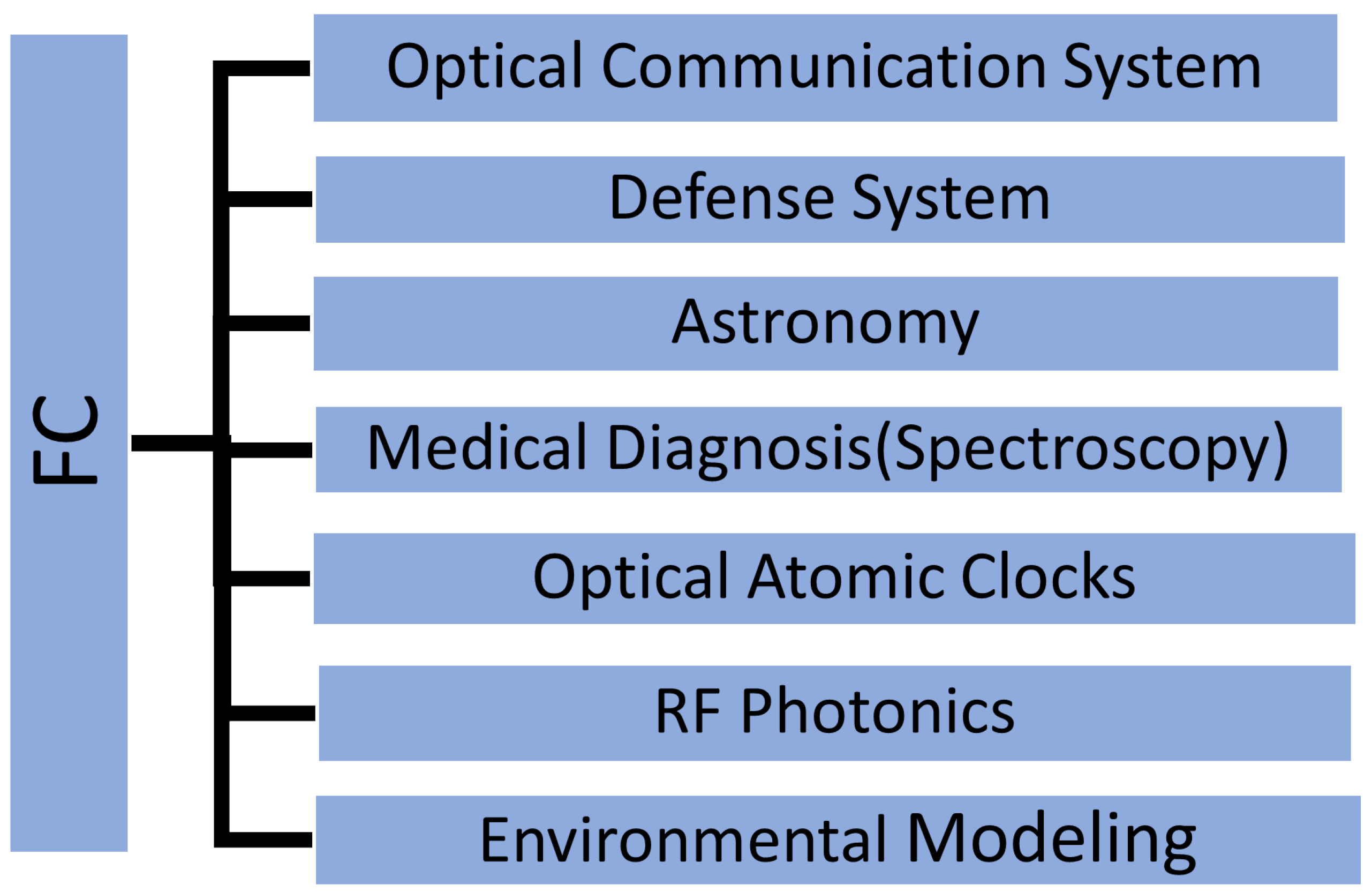
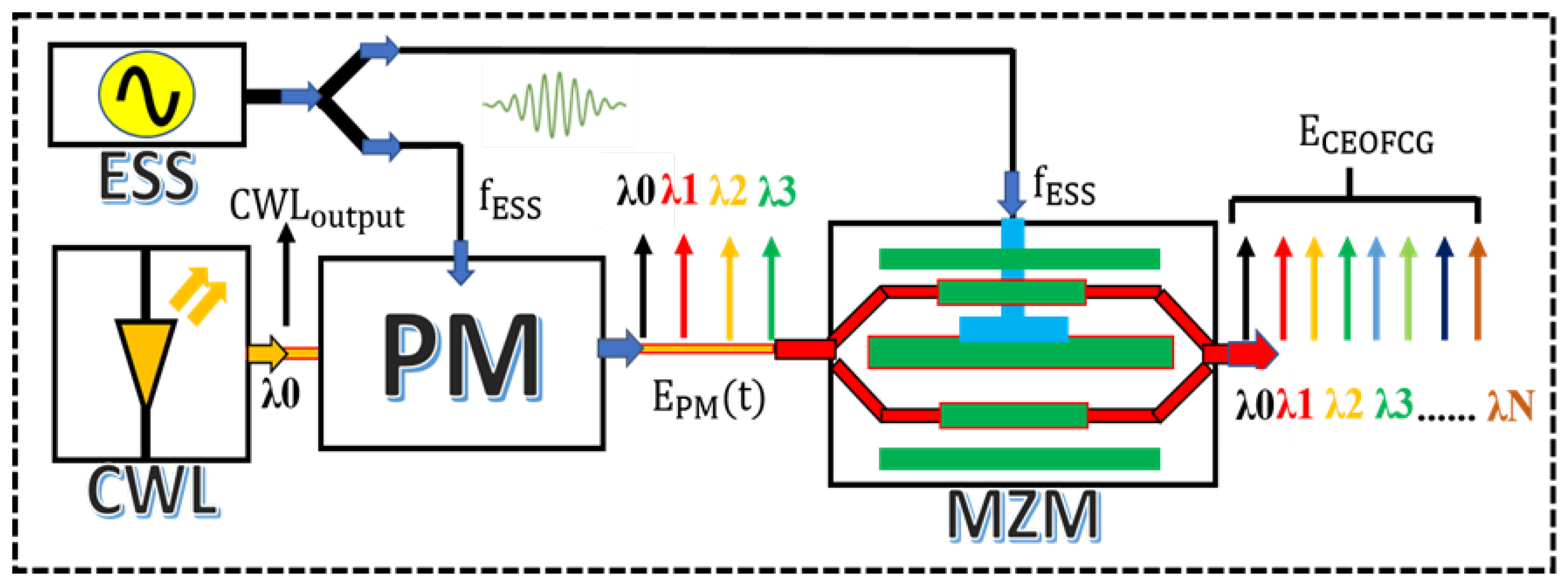
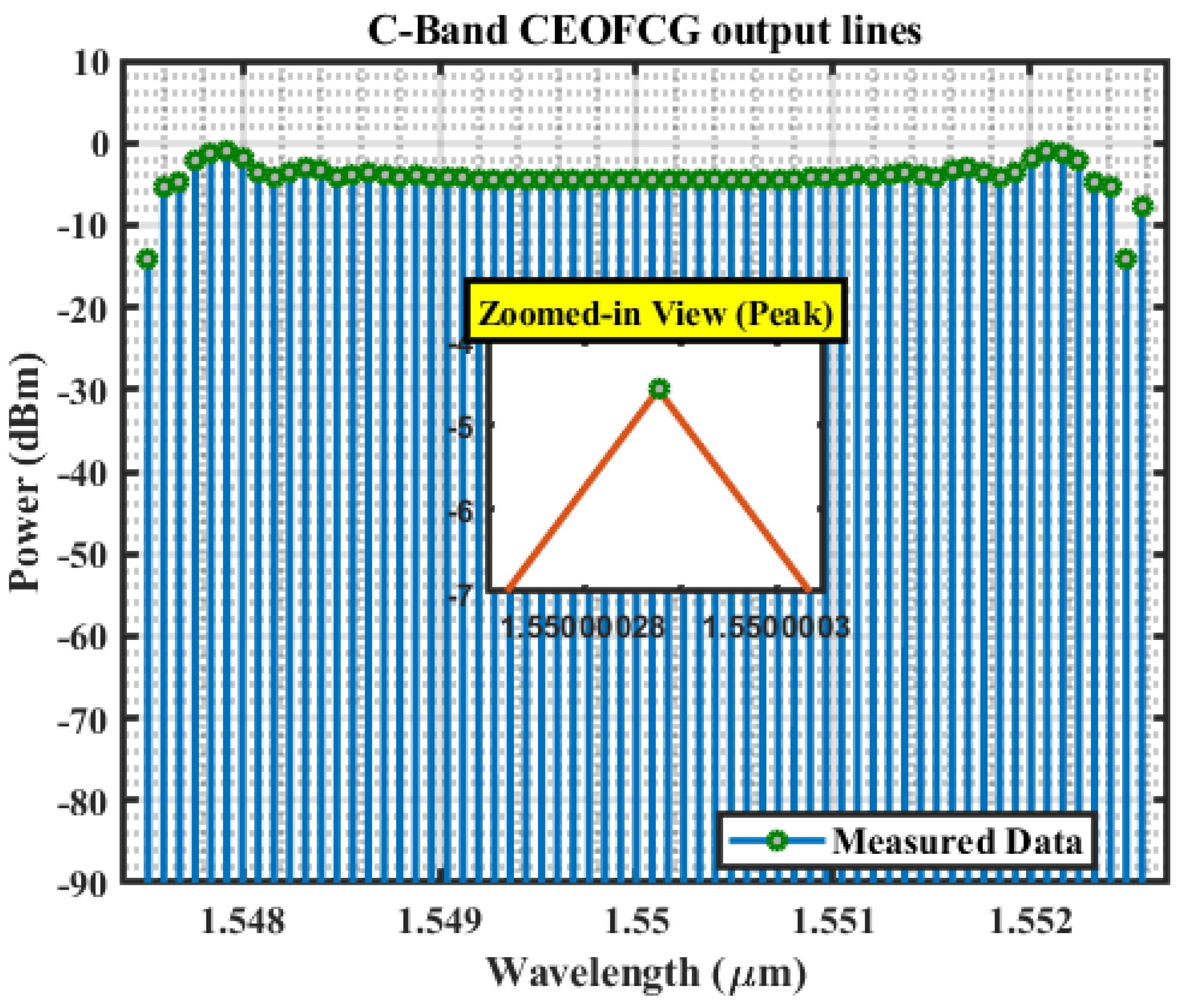
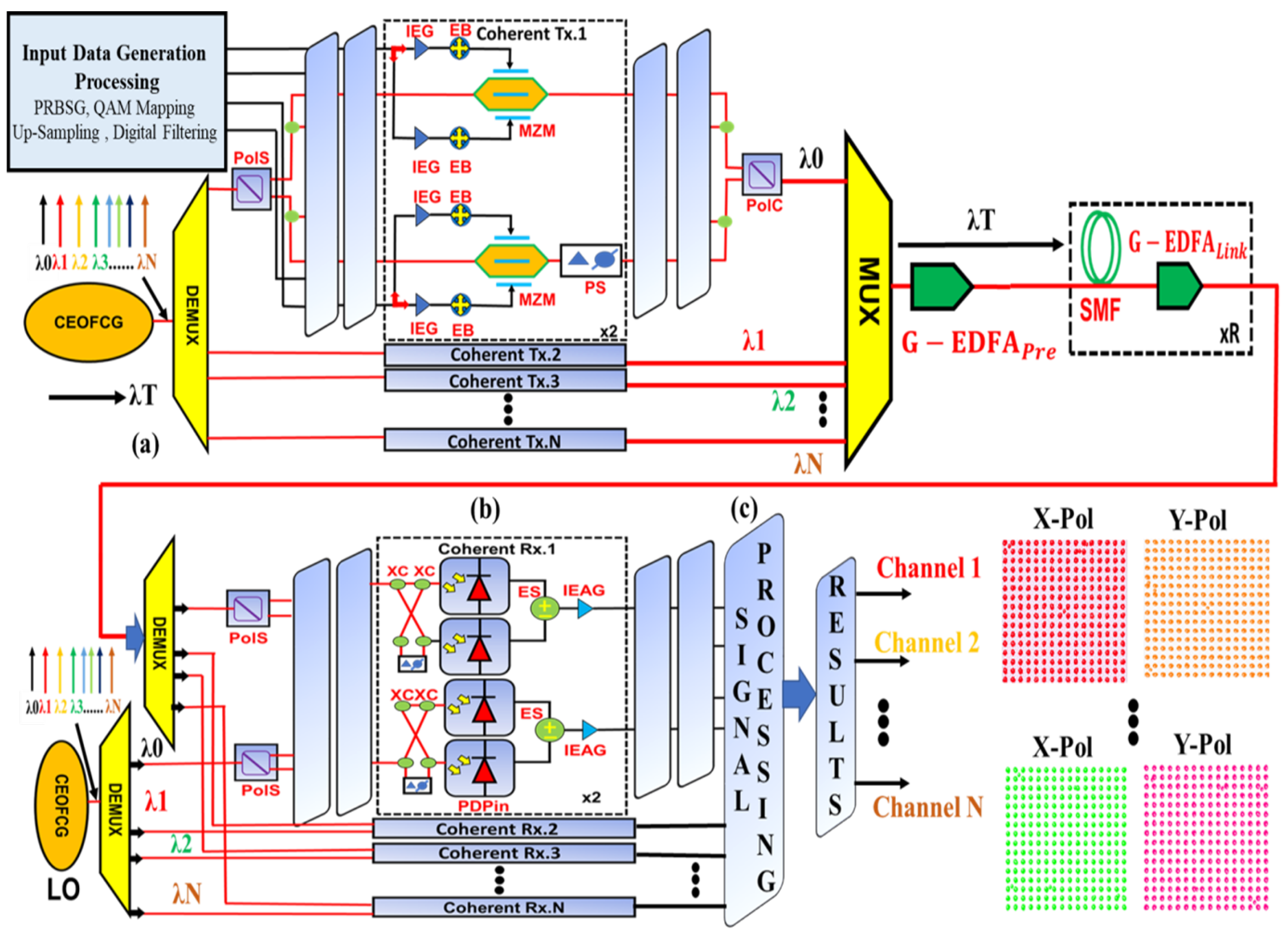


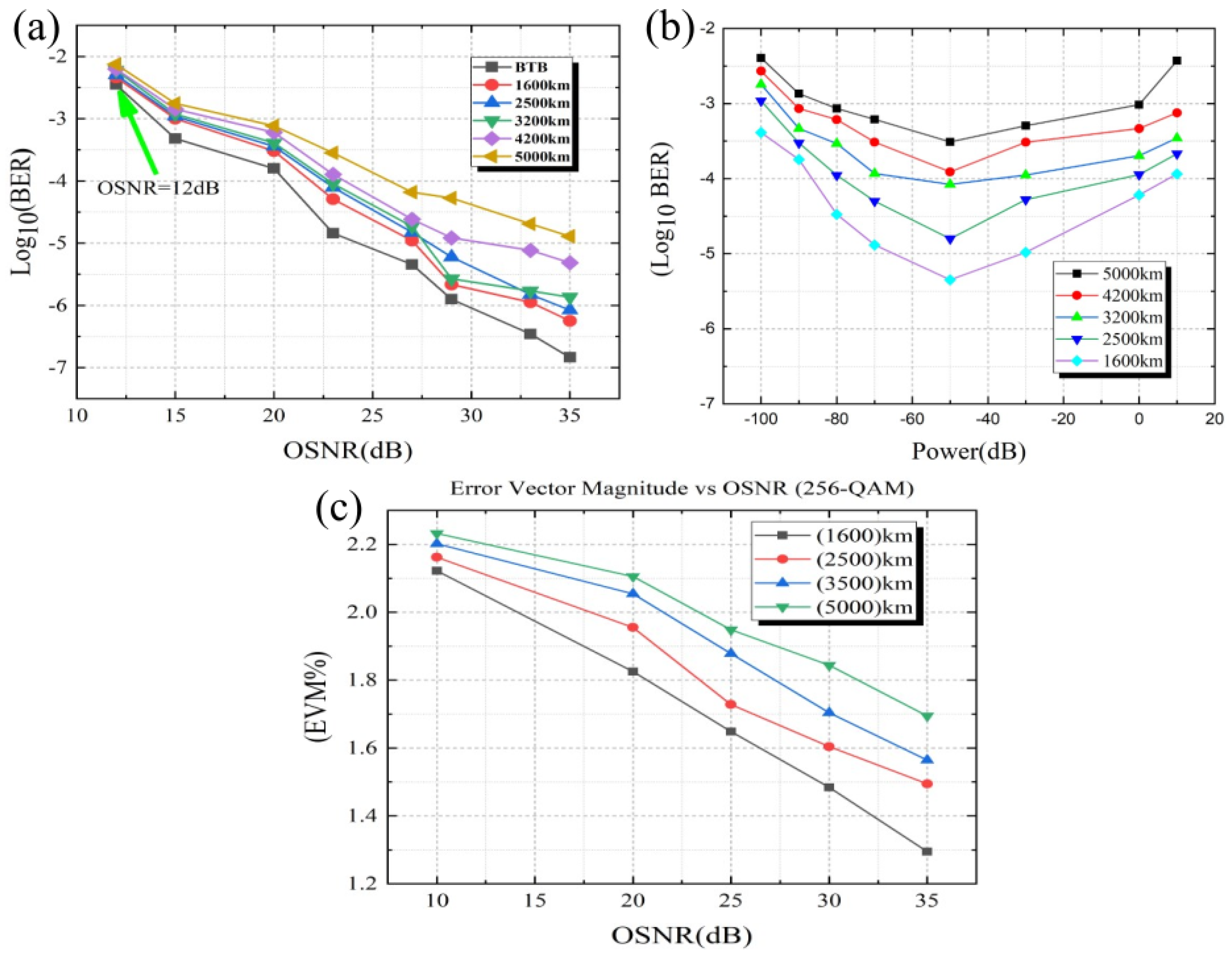
| Name of Parameters | Parameters Values |
|---|---|
| Transmission Parameter | |
| Symbol Rate | 20 Gsymbol/s |
| Modulation Format | DP-256 QAM |
| Bit Rate | 320 Gbit/s |
| Number of Samples | 524,288 |
| Reference Wavelength | 1550 nm |
| Guard Bits | 20 Guard bits |
| Link Parameter | |
| Attenuation of Fiber | 0.2 dB/km |
| Dispersion Coefficient | 16.75 ps/nm/km |
| Nonlinearity of Fiber | 1.2 (W.km)−1 |
| Gain in EDFA | 16 dB |
| Noise Figure of EDFA | 4.5 dB |
Disclaimer/Publisher’s Note: The statements, opinions and data contained in all publications are solely those of the individual author(s) and contributor(s) and not of MDPI and/or the editor(s). MDPI and/or the editor(s) disclaim responsibility for any injury to people or property resulting from any ideas, methods, instructions or products referred to in the content. |
© 2025 by the authors. Licensee MDPI, Basel, Switzerland. This article is an open access article distributed under the terms and conditions of the Creative Commons Attribution (CC BY) license (https://creativecommons.org/licenses/by/4.0/).
Share and Cite
Ali, B.; Murtaza, G.; Bilal, H.M.; Mahmood, T.; Rashid, M.; Ullah, Z. Optical Frequency Comb-Based 256-QAM WDM Coherent System with Digital Signal Processing Algorithm. Chips 2025, 4, 16. https://doi.org/10.3390/chips4020016
Ali B, Murtaza G, Bilal HM, Mahmood T, Rashid M, Ullah Z. Optical Frequency Comb-Based 256-QAM WDM Coherent System with Digital Signal Processing Algorithm. Chips. 2025; 4(2):16. https://doi.org/10.3390/chips4020016
Chicago/Turabian StyleAli, Babar, Ghulam Murtaza, Hafiz Muhammad Bilal, Tariq Mahmood, Muhammad Rashid, and Zaib Ullah. 2025. "Optical Frequency Comb-Based 256-QAM WDM Coherent System with Digital Signal Processing Algorithm" Chips 4, no. 2: 16. https://doi.org/10.3390/chips4020016
APA StyleAli, B., Murtaza, G., Bilal, H. M., Mahmood, T., Rashid, M., & Ullah, Z. (2025). Optical Frequency Comb-Based 256-QAM WDM Coherent System with Digital Signal Processing Algorithm. Chips, 4(2), 16. https://doi.org/10.3390/chips4020016







